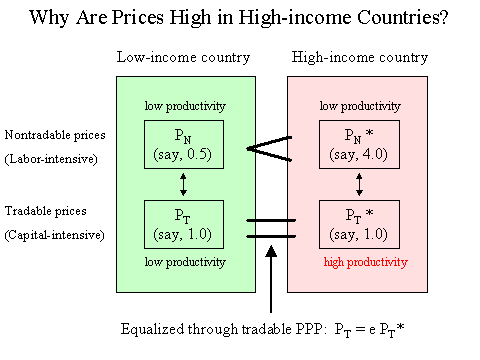Balassa Samuelson effect is one of the influential theories in macroeconomics and international economics that figures out the differences in relative prices of non-tradable products between developed and developing economies. Hungarian economist Bela Balassa and Noble Laureate Paul Samuelson propounded this theory.
To understand more clearly, let's be clear on tradable and non-tradable products. Those products that can be easily transported and exchanged are called tradable goods such as electronic items, software, etc. Likewise, non-tradable products are those that are immobile, such as hair cutting services, beauty parlour services, housing services, etc.
After understanding these concepts, it will be easier to understand this theory. Balassa and Samuelson recognise productivity as the major factor influencing wage rate. They considered manufacturing sector for their analysis. Person engaged in manufacturing sector in developed economies earn more compared to person working in same sector in developing or underdeveloped economies because of difference in productivity. The higher wage rate in one sector affects the wage rate in another sector, which is called the spillover effect. So, in advanced economies, wage rate is higher in all sectors. On contrary, wage rate is low in all sectors.
Aforementioned, tradable goods are mobile, so law of one price always holds true. Arbitrage takes place if price differential exists, which eventually results to equalization of prices. For example, iPhone is priced more or less similar elsewhere (tax and fringe cost ignored). But, this is not true for non-tradable goods. For example, John, a barber, in Nepal earns Rs.200 per Haircut but he may earn Rs.1000 in the US. John wants to go to the US and earn Rs.1000 per haircut. Unfortunately, multiple legal regulations prevent him from departing. Thus, the price of non-tradable goods in developing and undeveloped economics is less compared to developed economies.
Moreover, this theory provided valuable insights on determination of exchange rate. Economies with higher productivity growth in tradable sector have higher exports. The higher exports contribute in appreciating the value of domestic currency. Thus, fast growing economies may experience appreciation in currency even in absence of interest rate differentials or inflation differentials.
In conclusion, developed economies have higher productivity growth that leads to higher wage rate. Consequently, higher wage rate leads to higher inflation. On other hand, higher productivity growth also enhances competitiveness in the international market that leads to appreciation of currency. Thus, productivity differential can also lead to exchange rate differential.
In their original article, they have compared prices in Norway and Mexico and explored these phenomena discussed above.


Post a Comment